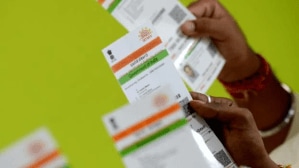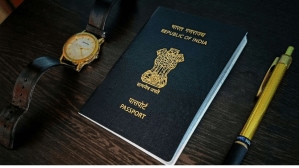Creating a six-yard Bomkai saree is not easy— it is time consuming and labour intensive. No one can know it better than Binod Meher. “It roughly takes seven to nine months to create such a product,” says the second-generation ikat weaver from Sonepur in Odisha.
Bomkai is a handloom saree which is created by making use of the dyeing technique called ikat. It originated in the village of Bomkai in Odisha’s Ganjam district. It got a GI (geographical indication) tag in 2009, which means it is considered original only if it is made in Bomkai or Sonepur.
“The time taken to make an original piece of ikat is longer, as this craft involves complex pattern processes in delicate silk yarns,” he adds. No wonder Meher takes months to weave such a fabric in silk threads to bring out exquisite designs that can cost anywhere from Rs 15,000 and go up to Rs 1 lakh, depending on the pattern.
According to Meher, ikat is in great demand, as people are now aware and are also looking for original craft. “Sonepur ikat is famous for woven sarees and dress materials in Bomkai designs. It is also known for its intricacy. It has been personally liked and worn by actors such as Aishwarya Rai and Vidya Balan. Even men are seen wearing this pattern nowadays,” shares Meher.
It’s true that ikat has gained immense popularity and is now worn by people across genders and age groups. Evergreen and prevalent, the dyeing technique is now going through a revolution, especially with new-age brands, fashion houses and designers introducing this heritage weave in innovative designs and patterns.
Online marketplaces like Myntra and Amazon have dupattas, sarees, shirts and fabrics in ikat that can start from Rs 600 and go up to Rs 8,000.
Ikat can have different price points depending on the technique and usage —it can be a very expensive patan patola saree from Gujarat or a modest ikat fabric from Telangana used for curtains or bed sheets. Textile revivalist and curator Lavina Baldota says: “A cheapest ikat can cost around Rs 300 per metre. A single ikat (in which the warp or weft yarns are dyed) is less expensive than a double (where both the warp and weft yarns are dyed). The weaves are expensive but if we want to take the craft from the local level to the global stage, awareness and advocacy are important,” she adds.
Ikat textile production is quite labour intensive too. Hence, good quality products are priced on a higher side. “An authentic ikat product starts from Rs 400-500 and goes up to Rs 1,500 per metre depending on the weave, design and material. However, more than 50-60% of the products being produced and sold in the mainstream market are fake—these are digital screen prints or made on power looms,” says Nitin Pamnani, co-founder of handicrafts and handloom brand iTokri.
A new twist
Fashion designer Arjun Khanna has recently adapted the age-old print in a new manner. He has designed an ikat collection in fiery red, which is aimed at the festive season. “Ikat blends in easily with what you wear. Today, everyone wants to wear colours and experiment with different prints. It is globally appealing,” adds Khanna, who has launched the collection in bundi and fitted short kurta and teamed up with aligarhi pants and jodhpurs.
Khanna has done a lot of tone-on-tone and texture-on-texture embroidery in geometric patterns, eye-catching hues and vibrant shades. The collection is around ikat prints that have taken inspiration from Persian rugs and carpets.
Art exhibitions are also now making sense of the handloom in ways one cannot think of. Painted Stitches, Woven Stories, an ongoing digital exhibition by the Museum of Art and Photography (MAP) in Bengaluru, depicts interaction between the 19th- and 20th-century textiles of Central Asia, Southeast Asia and the Indian subcontinent with contemporary art. It evokes environmental, emotional and sensorial nuances through a series of questions—How do makers tie and dye textiles? What is the link between sunlight, water and dying of cloth? Did common people and the royalty clothe themselves with the same type of garments? How do patterns and motifs indicate local customs? How did the design of resist dyed textiles affect trade between the Indian subcontinent and other regions of the world?
Arnika Ahldag, associate curator at MAP and co-curator of the exhibition, says, “Indian textiles have a fascinating history across different states in India and the world. Ikat ranges from simple symmetrical to large geometric patterns and abstract zoomorphics. The exhibition highlights how ikat, bandhani and leheriya have made their way into visual arts and decodes what a seemingly abstract pattern signifies for those who have the pleasure to wear it.”
The show is a glimpse into the mysterious ways in which tie-dyeing appears on threads, veils, trims and unstitched textiles. Vaishnavi Kambadur, assistant curator at MAP and co-curator of the exhibition, adds, “Artworks from Uzbekistan and Southeast Asia next to the ones from India create a mind-map of trade, design and cultural connections. The show expands on how many makers share their processes with each other and yet preserve the regional histories of ikat, bandhani and leheriya.”
Going global
Gradually, ikat is gaining global appeal. For instance, the Frieda dress by Ralph Lauren has prints in patchwork of colourful ikat-inspired motifs. The prints and patterns are inspired by designs traditional to Uzbekistan and Tajikistan, and cultures throughout Asia. The interwoven global history of ikat techniques—from as early as the 10th century—holds historical symbolism and varied origins across cultures in the Middle-East, Asia, Africa and Latin America.
“Ikat has a huge appeal in the global market. Many fashion designers in Europe and the US have been unfortunately using ikat as prints for their collection. The recent Ralph Lauren collection is inspired by ikat, but they have used the print and not the real weave. So, if we bring the eyeballs to what is available in India, which is even cheaper than printing, we could really help this industry grow and help the weavers revive the textile market,” says textile revivalist and curator Lavina Baldota.
Crocs, a casual footwear brand for women, men and children, has done an exclusive partnership with multi-category retailer brand Chumbak to create a limited-edition collection inspired by the intricate patterns of ikat and paisleys. Traditional ikat prints have been juxtaposed with jibbitz inspired by Indian karigari and popular motifs. The Chumbak X Crocs Classic clogs are a modern take on the heritage art form.
Sumit Dhingra, vice-president and general manager, India & SEA, Crocs, says, “Classic clogs are a perfect canvas for self-expression. In the past, we have partnered with leading brands and personalities like Balenciaga, Drew House by Justin Bieber, Post Malone, etc. These collaborations have been phenomenally successful achieving a sell-out within minutes across the globe.”
Many brands have revived ikat among traditional artisan and fashion products. Troy by designers Sanjana & Aanchal of Bubber Couture is an ode to the Trojan war in the Battle of Troy. In the festive collection, ikat has a bold vibe with a play on armour, grain lines, Roman-inspired drapes, patchwork and gilded with aged metal and stud embroideries. The collection is inspired from Trojan shields, chain mail, armour and battle gear. The prints are designed for ‘Troy’ using the Greek Trojan war theme, industrial blueprints and ikat textiles as an inspiration.
According to Dipali Patwa, former group head of brand and community, Fabindia, ikat is a global craft, with many countries and cultures having their own weaving techniques, independent of each other, like Uzbekistan, Indonesia, Africa and South America. This makes it unique and relatable globally. “In India, the three major regions —Andhra Pradesh/ Telangana, Gujarat and Odisha—have developed their own style of weaving; each distinct in pattern and the way the yarn is dyed and used,” she adds.
Fabindia recently used ikat patterns in a collection of newly designed cabinets and mirrors. Each piece in the collection is a unique interpretation of ikat and is crafted with small glass-cut beads on solid ribbed wood. The detailed geometric pattern, inspired from ikat, uses sophisticated artistry and craftsmanship on the panels and frames of the structure. Similarly, the brand also launched a tableware collection that has intricate ikat pattern hand decaled onto the porcelain.
While ikat is currently high in demand, which results in an increase in production, Pamnani of iTokri has in the past three years seen a good acceptance for the fabric, largely in the fashion industry, as many designers have started using ikat for products and creating new style statements. “Ikat is known for its quality and amazing weaving patterns. It is a commonly used fabric in the market now. It is used for making handbags, designer sarees, carpets and many more,” says Pamnani, who has been working with more than 100 ikat artisans from Telangana and Andhra Pradesh for over 10 years now.
The key is to take traditional Indian handcrafted fabric and give it a modern spin. Accessories brand Zouk did that with ikat. “We are on a mission to bring stylish and functional products with an essence of India,” says Pradeep Krishnakumar, co-founder and COO of Zouk. “Some of our bestsellers like laptop bags, office bags for women and wallets use ikat fabric extensively. Interestingly, our ikat laptop bag even appeared organically in the Vidya Balan movie Sherni,” explains Krishnakumar, adding that Zouk sources ikat fabrics from artisans across Tamil Nadu, Telangana and Maharashtra who weave them by hand.
Supporting artisans
Scaling 16x from pre-Covid levels, Zouk has been able to share that growth in orders with its ikat weaver partners too. “This supports artisans to continue weaving these fabrics in the most traditional formats and keep the process alive,” says Krishnakumar, who has done some bespoke international orders for buyers in Canada, Germany, Switzerland and the Middle-East in the past.
In India, artisans from three prominent regions are practising ikat—Rajkot and Patan in Gujarat; Sambalpur, Nuapatna and Bargarh in Odisha; and Pochampally in Telangana. Anindita Sardar, head—design and curation at Taneira, a women’s wear brand, is closely working with artisans and weavers of these regions. “We offer sarees in cotton and silk from these clusters and support them in the formation stage. Collaboration with fashion and global brands specific to ikat definitely holds immense potential in the future,” she says.
Obeetee Retail, a hand-knotted carpet and hand-tufted carpet manufacturer, has also taken CSR activities to work in craft clusters such as Patola in Gujarat, Telia Rumal in Telangana and Sambalpur in Odisha, to develop different product lines not only at the domestic but also at the international level. Angelique Dhama, CEO of Obeetee, says, “Ikat is an important part of the history of crafts. Besides advocating craftsmen’s skills, designs and qualities, it is good to give them exposure to different product lines and markets. Obeetee has taken inspiration from ikat and designed a rug collection called Seville that is a top-selling line among international buyers.”
A cheapest ikat can cost Rs 300 per metre. The weaves are expensive but if we want to take the craft from the local level to the global stage, awareness & advocacy are important
— Lavina Baldota, textile revivalist & curator
Some of our bestselling products like laptop bags and wallets use ikat fabric extensively. We are on a mission to bring stylish and functional products with an essence of India
— Pradeep Krishnakumar, co-founder & COO, Zouk
We are working closely with artisans and weavers from Gujarat, Odisha and Telangana. Collaboration with global brands specific to ikat holds immense potential
— Anindita Sardar, head, design & curation, Taneira
Ikat is an important part of the history of crafts. Besides advocating craftsmen’s skills and designs, it is good to give them exposure to different product lines and markets
— Angelique Dhama, CEO, Obeetee








